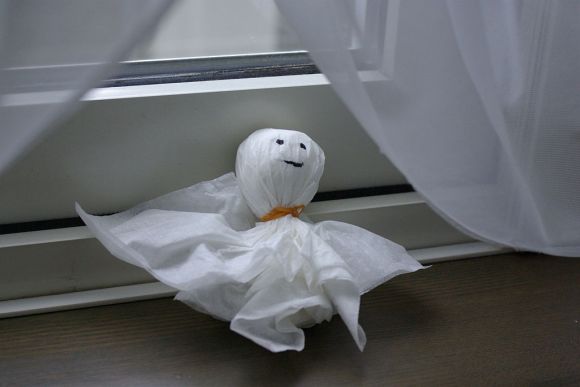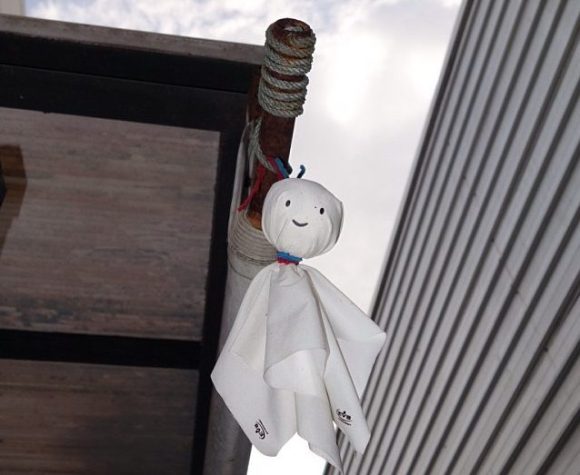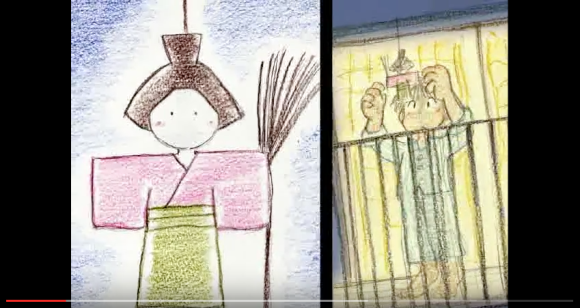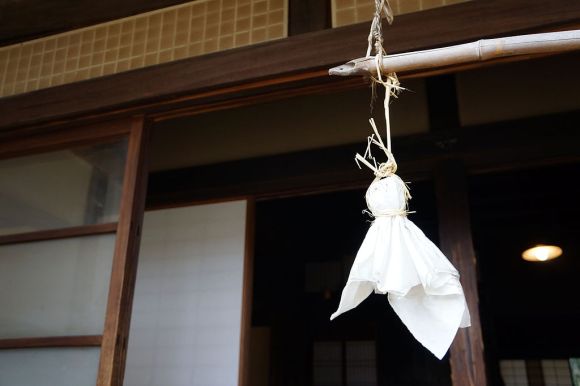
While many believe the tradition of making the ghost-like doll can be traced back to a bald-headed monk, history suggests it actually began with a small girl.
In Japan, children are taught from an early age about the wondrous powers of the teru teru bozu, which translates to shiny baldhead (monk). Easily made from two squares of tissue or cloth, the doll is said to represent a monk’s bald head, and is made when fine weather, which would make its head shiny, is desired the following day. While the tradition is well-practiced and well-known, many Japanese people remain unsure of the origins of the doll; seeing it instead as something they’ve simply been taught to do when good weather is required, ahead of events like sports days, ceremonies and special celebrations.
▼ Traditionally, if the wish for clear skies was granted, the doll was rewarded with drawn-on eyes and a dousing of holy sake and then sent down the river to be washed away.
Hung under the eaves of the house, the teru teru bozu even has an accompanying song, usually sung by children as the doll is being made, acting as a chant to invoke sunny skies the following day. The lyrics to the song, which was released in 1921, actually give us some clues to the doll’s origins and history. The three verses can be translated as:
Teru-teru-bozu, teru bozu/ Do make tomorrow a sunny day/ Like the sky in a dream sometime/If it’s sunny I’ll give you a golden bell
Teru-teru-bozu, teru bozu/ Do make tomorrow a sunny day/ If you make my wish come true/ We’ll drink lots of sweet rice wine
Teru-teru-bozu, teru bozu/ Do make tomorrow a sunny day/ But if the clouds are crying/ Then I shall snip your head off
The origins of the teru teru bozu talisman remain vague, with some saying the dark lyrics towards the end of the popular song refer to a “Good Weather Monk”, who was able to bring fine weather with an incantation. However, after promising good weather to a feudal lord, the sunshine did not appear as promised and the monk’s head was chopped off as punishment. It’s said the monk’s head was then wrapped in cloth and hung outside to stop the rain and bring out the sun.
A less horrifying theory suggests the talisman represents a yokai spirit from the mountains called Hiyoribo, who brings fine weather and can’t be seen on rainy days.
According to the Japan Weather Association, which runs the country’s popular tenki.jp weather app, the tradition of teru teru bozu spread to Japan from China during the Heian Period (794-1185) and can be traced back to a custom that suggests the person charged with invoking good weather was not a monk but a broom-carrying girl.
As the story goes, during a time of heavy and continuous rainfall, a voice from the heavens warned the people that their city would be submerged if a certain beautiful young girl did not appear outside. To save people from the deluge, the girl was essentially sacrificed, sent outside with a broom to symbolically head to the heavens where she would sweep rain clouds from the sky. In order to remember the brave girl who brought clear skies, young ladies would recreate her figure in paper cut-outs, a skill in which the broom-carrying girl once excelled. These figures were then hung outside to bring sunshine in times of rain.
Known as 掃晴娘 (So-Chin-Nyan) or Souseijou in Japanese, which literally means “sweeping fine weather girl”, the paper doll concept gradually took on a different face in Japan, eventually becoming the teru teru bozu we see today. This theory, which has the support of folk historians, sheds light on the origins of the weather talisman, which, with the rainy season still well underway, will be popping up outside windows and under rooftops around the country.
If you’d like to see the broom-carrying fine weather girl in action, check out the animated short below.
Source: Spotlight
Top Image:Wikimedia Commons/Jun OHWADA
Insert Images: Wikimedia Commons/Keng Susumpow, Wikimedia Commons, Wikimedia Commons, Wikimedia Commons/Kentaro Ohno, Youtube/zqdym
Follow Oona on Twitter for more news on traditional Japanese culture and customs.






 Should you dip your cake in sake? One Japanese brewer says no, but actually yes【 Taste test】
Should you dip your cake in sake? One Japanese brewer says no, but actually yes【 Taste test】 Majority of Japanese mayors say foreign residents are essential but most see good and bad effects
Majority of Japanese mayors say foreign residents are essential but most see good and bad effects Hypnosis bar opens in Tokyo, with prizes for those who don’t fall into a hypnotic state
Hypnosis bar opens in Tokyo, with prizes for those who don’t fall into a hypnotic state Starbucks Japan ready to get Year of the Horse started with adorable drinkware and plushies【Pics】
Starbucks Japan ready to get Year of the Horse started with adorable drinkware and plushies【Pics】 Top Secret Cookie Recipe Finally Comes to Light
Top Secret Cookie Recipe Finally Comes to Light Should you dip your cake in sake? One Japanese brewer says no, but actually yes【 Taste test】
Should you dip your cake in sake? One Japanese brewer says no, but actually yes【 Taste test】 Majority of Japanese mayors say foreign residents are essential but most see good and bad effects
Majority of Japanese mayors say foreign residents are essential but most see good and bad effects Hypnosis bar opens in Tokyo, with prizes for those who don’t fall into a hypnotic state
Hypnosis bar opens in Tokyo, with prizes for those who don’t fall into a hypnotic state Starbucks Japan ready to get Year of the Horse started with adorable drinkware and plushies【Pics】
Starbucks Japan ready to get Year of the Horse started with adorable drinkware and plushies【Pics】 Top Secret Cookie Recipe Finally Comes to Light
Top Secret Cookie Recipe Finally Comes to Light Japanese thug wear from Birth Japan perfect for those breaking bad next year
Japanese thug wear from Birth Japan perfect for those breaking bad next year Stamina-destroying “Paralysis Noodles” are Tokyo’s newest over-the-top ramen innovation
Stamina-destroying “Paralysis Noodles” are Tokyo’s newest over-the-top ramen innovation Muscly Japanese men fill stock photo site with hilarious poses in unusual settings
Muscly Japanese men fill stock photo site with hilarious poses in unusual settings How much difference does the choice of mold make in fermenting food?
How much difference does the choice of mold make in fermenting food? Record number of foreign children in Japan need help understanding Japanese in school
Record number of foreign children in Japan need help understanding Japanese in school Hayao Miyazaki says Happy New Year to Studio Ghibli fans with new art for Year of the Horse
Hayao Miyazaki says Happy New Year to Studio Ghibli fans with new art for Year of the Horse Japanese beef bowl chain Sukiya’s 2026 Smile Box lucky bag basically pays for itself
Japanese beef bowl chain Sukiya’s 2026 Smile Box lucky bag basically pays for itself We found possibly the quietest Japanese-style hotel in Tokyo’s bustling Shinjuku district
We found possibly the quietest Japanese-style hotel in Tokyo’s bustling Shinjuku district Cup Noodle tries an authentic Jiro-style ramen, but something’s not quite right
Cup Noodle tries an authentic Jiro-style ramen, but something’s not quite right The best Starbucks Japan Frappuccinos we want to drink again in 2026
The best Starbucks Japan Frappuccinos we want to drink again in 2026 We revisited Sweets Paradise after a decade to see if Japan’s dessert buffet still delivers
We revisited Sweets Paradise after a decade to see if Japan’s dessert buffet still delivers That time Seiji called JASRAC to ask why he didn’t get paid royalties for his song being on TV
That time Seiji called JASRAC to ask why he didn’t get paid royalties for his song being on TV Japan’s oldest largetooth sawfish in captivity back on display in Mie Prefecture
Japan’s oldest largetooth sawfish in captivity back on display in Mie Prefecture Pizza Hut Japan’s hot lucky bags are perfect for a New Year’s pizza party
Pizza Hut Japan’s hot lucky bags are perfect for a New Year’s pizza party 7-Eleven Japan starts new temporary luggage storage service in over 300 branches
7-Eleven Japan starts new temporary luggage storage service in over 300 branches Disillusionment at Tsukiji’s tourist-target prices led us to a great ramen restaurant in Tokyo
Disillusionment at Tsukiji’s tourist-target prices led us to a great ramen restaurant in Tokyo Starbucks teams up with 166-year-old Kyoto doll maker for Year of the Horse decorations【Photos】
Starbucks teams up with 166-year-old Kyoto doll maker for Year of the Horse decorations【Photos】 Tokyo considering law requiring more trash cans following litter increase in heavily touristed area
Tokyo considering law requiring more trash cans following litter increase in heavily touristed area Tokyo’s Tsukiji sushi neighborhood asks tour groups to stay away for the rest of the month
Tokyo’s Tsukiji sushi neighborhood asks tour groups to stay away for the rest of the month Tokyo event lets you travel back in time, for free, to celebrate 100 years since Showa era start
Tokyo event lets you travel back in time, for free, to celebrate 100 years since Showa era start Japan may add Japanese language proficiency, lifestyle classes to permanent foreign resident requirements
Japan may add Japanese language proficiency, lifestyle classes to permanent foreign resident requirements Sanrio theme park in Japan announces plans to expand into a Sanrio resort
Sanrio theme park in Japan announces plans to expand into a Sanrio resort Survey asks foreign tourists what bothered them in Japan, more than half gave same answer
Survey asks foreign tourists what bothered them in Japan, more than half gave same answer Japan’s human washing machines will go on sale to general public, demos to be held in Tokyo
Japan’s human washing machines will go on sale to general public, demos to be held in Tokyo Japan’s deadliest food claims more victims, but why do people keep eating it for New Year’s?
Japan’s deadliest food claims more victims, but why do people keep eating it for New Year’s? We deeply regret going into this tunnel on our walk in the mountains of Japan
We deeply regret going into this tunnel on our walk in the mountains of Japan Studio Ghibli releases Kodama forest spirits from Princess Mononoke to light up your home
Studio Ghibli releases Kodama forest spirits from Princess Mononoke to light up your home Major Japanese hotel chain says reservations via overseas booking sites may not be valid
Major Japanese hotel chain says reservations via overseas booking sites may not be valid Put sesame oil in your coffee? Japanese maker says it’s the best way to start your day【Taste test】
Put sesame oil in your coffee? Japanese maker says it’s the best way to start your day【Taste test】 No more using real katana for tourism activities, Japan’s National Police Agency says
No more using real katana for tourism activities, Japan’s National Police Agency says Starbucks Japan reveals new sakura drinkware collection, inspired by evening cherry blossoms
Starbucks Japan reveals new sakura drinkware collection, inspired by evening cherry blossoms Updated cherry blossom forecast shows extra-long sakura season for Japan this year
Updated cherry blossom forecast shows extra-long sakura season for Japan this year Japanese thug wear from Birth Japan perfect for those breaking bad next year
Japanese thug wear from Birth Japan perfect for those breaking bad next year Stamina-destroying “Paralysis Noodles” are Tokyo’s newest over-the-top ramen innovation
Stamina-destroying “Paralysis Noodles” are Tokyo’s newest over-the-top ramen innovation Muscly Japanese men fill stock photo site with hilarious poses in unusual settings
Muscly Japanese men fill stock photo site with hilarious poses in unusual settings How much difference does the choice of mold make in fermenting food?
How much difference does the choice of mold make in fermenting food? Record number of foreign children in Japan need help understanding Japanese in school
Record number of foreign children in Japan need help understanding Japanese in school Which Japanese convenience store has the best miso vegetable stick pack?【Taste test】
Which Japanese convenience store has the best miso vegetable stick pack?【Taste test】 Starbucks Japan releases the new Soupuccino, but is it everything it’s cracked up to be?
Starbucks Japan releases the new Soupuccino, but is it everything it’s cracked up to be? Discover some of the best snacks in Atami, a wonderland of Japanese street food
Discover some of the best snacks in Atami, a wonderland of Japanese street food Cup Noodles Everything Bagel surprises ramen lovers around the world
Cup Noodles Everything Bagel surprises ramen lovers around the world Mt Fuji and Raijin and Fujin lingerie sets let you wear your love for Japan under your clothes
Mt Fuji and Raijin and Fujin lingerie sets let you wear your love for Japan under your clothes Eight Ways You Really, Really Shouldn’t Use a Japanese Toilet
Eight Ways You Really, Really Shouldn’t Use a Japanese Toilet
Leave a Reply